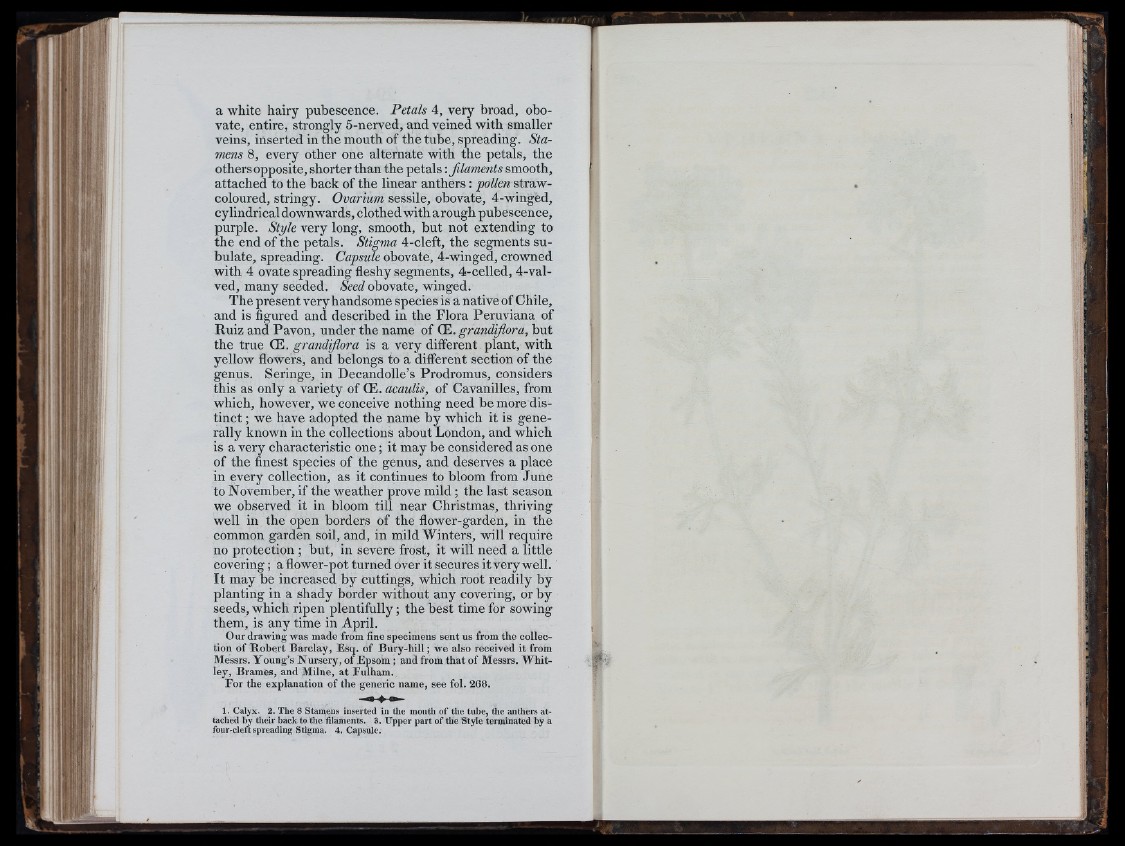
a white hairy pubescence. Petals 4, very broad, obovate,
entire, strongly 5-nerved, and veined with smaller
veins, inserted in th e mouth of the tube, spreading. Stamens
8, every other one alternate with th e petals, the
others opposite, shorter than the p e ta ls : Jilaments smooth,
attached to the back of the linear a n th e rs : pollen straw-
coloured, stringy. Ovarium sessile, obovate, 4-winged,
cylindrical downwards, clothed with a rough pubescence,
purple. Style very long, smooth, b u t not extending to
th e end of the petals. Stigma 4-cleft, the segments subulate,
spreading. Capsule obovate, 4-winged, crowned
with 4 ovate spreading fleshy segments, 4-celled, 4-valved,
many seeded. Seed obovate, winged.
The present very handsome species is a native of Chile,
and is figured and described in the Flora Peruviana of
Ruiz and Pavon, under the name of OE. grandiflora, bu t
the true CE. grandiflora is a very different plant, with
yellow flowers, and belongs to a different section of the
genus. Seringe, in Decandolle’s Prodromus, considers
this as only a variety of (E. acaulis, of Cavanilles, from
which, however, we conceive nothing need be more distin
c t ; we have adopted the name b y which it is generally
known in the collections about London, and which
is a very characteristic o n e ; it may be considered as one
of the finest species of the genus, and deserves a place
in every collection, as it continues to bloom from June
to November, if the weather prove m ild ; the last season
we observed it in bloom till near Christmas, thriving
well in the open borders of the flower-garden, in the
common garden soil, and, in mild W inters, will require
no protection ; but, in severe frost, it will need a little
covering; a flower-pot turned over it secures it very well.
I t may be increased by cuttings, which root readily by
planting in a shady border without any covering, or by
seeds, which ripen p lentifully; the best time for sowing
them, is any time in April.
Our drawing was made from fine specimens sent us from the collection
of Robert Barclay, Esq. of B u ry-hill; we also received it from
Messrs. Y oung’s Nursery, of Epsom; and from that of Messrs. W h itley,
Brames, and Milne, at Fulham.
For the explanation of the generic name, see fol. 268.
1. Calyx. 2. The 8 Stamens inserted in the mouth o f the tube, the anthers attached
by their back to the filaments. 3. Upper part o f the Style terminated by a
four-cleft spreading Stigma. 4. Capsule.
ill
i9 'iis